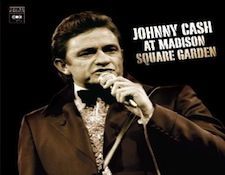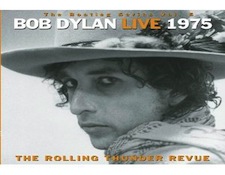It’s the time of year for saving money!

Johnny Cash – At Madison Square Garden
The good folks at Columbia Records have deemed 2002 to be “The
Year of Johnny Cash.” In celebration of this auspicious annum they have been
releasing re-mastered versions of his entire back catalog. By and large this
flood of old recordings has done little to improve Cash’s reputation for uneven
studio work. Just because throwaway sessions such as “Johnny Cash Sings Ballads
of the True West” and “Silver” sound better, doesn’t improve them musically.
But among these old recordings, many of which would be better left
unrediscovered, appears a gem – Johnny
Cash At Madison Square Garden. At last, on one recording, we can hear for
ourselves why Johnny Cash is indeed a national treasure.
What makes Johnny Cash At
Madison Square Garden so much better than most of his other recorded
output? It captures what Johnny Cash does best – play music live in a direct
unadorned manner. No extra string parts, layered mixes, trendy arrangements, or
added sweetening dilutes his music on Johnny
Cash At Madison Square Garden. Instead we have twenty-five songs delivered
fresh, hot, and steaming from the Man himself. It doesn’t hurt that his regular
touring band is populated by the likes of W.S. Holland on drums, Bob Wooten and
Carl Perkins on electric guitars, and the Statler brothers and Carter family on
background vocals. Not only is his band made up of seasoned pros, but also they
have played with Cash for many years. The results can be heard in this live
set, taken from just one night. His ensemble has a loose tightness that only
comes from playing countless dates on the road together. They know what Johnny
will do next, often times seemingly before he does himself.
The format for this concert is a cross between a slick musical
review and an old-fashioned song-pull, where singers just do whatever catches
their fancy. Beginning with “Big River” Cash works his way through “Five Feet
High and Rising”, “I Still Miss Someone”, “Long Black Veil”, “Folsom River
Blues”, “A Boy Named Sue” “Cocaine Blues”, “Ballad of Ira Hayes”, and “Were You
There When They Crucified my Lord.” During the show Cash gives his sidemen a
chance to shine as well. Carl Perkins does a cameo spot on “Blue Suede Shoes,”
the Statler brothers perform “Flowers on the Wall,” and Mother Maybell Carter
sings her classic “Wildwood
Flower.”
For folks, especially younger folks, who have made an effort to
get into Johnny Cash and come away wondering why people think he is so great, Johnny Cash At Madison Square Garden
goes a long way toward showing why he’s special. If you want only one Johnny
Cash recording, this is the one to own.

Old and in the Gray – Old and in the Gray
17 years ago Jerry Garcia, David
Grisman, Peter Rowan, Vassar Clements, and John Kahn released the first and only
Old and In The Way LP. Although it
didn’t make a huge splash initially, its impact grew exponentially through the
years. Few albums have been as influential in introducing impressionable young
listeners to the joys of traditional acoustic music. After far too long a
time-span the remaining original contributors finally released a second helping
called, appropriately enough, Old and in
the Gray. Joined by Bryn Bright replacing the late John Kahn on bass and
Herb Pederson filling in for Jerry Garcia, this new amalgam’s music has that
same joyous spark as the original.
Old
and in the Gray isn’t bluegrass exactly,
more like folk-grass or olde-timey-grass. Less traditional material like John
Hartford’s “Good Old Boys,” Townes Van Zandt’s “Poncho and Lefty,” and
Jagger/Richard’s “Honky Tonk Woman,” join bluegrass standards Carter Stanley’s
“The Flood,” Ira Louvin’s “Childish Love,” and Bill Monroe’s “On The Old
Kentucky Shore,” to form an eclectic song mix. Compared to bands like Ricky
Skagg’s Kentucky Thunder or Del McCoury’s boys, Old and in the Gray sound sort of raggedy-ass. Instead of the
lock-step almost Prussian precision of many modern bluegrass bands Old and in the Gray are looser than a
dishrag. Harmonies, especially the baritone parts, have a certain elusive
vagueness to their pitch. Even Peter Rowan’s lead vocals often slide around
notes like a monkey on a well-greased pole. But Old and in the Gray’s looseness is endearing. These folks don’t
have to prove anything – they just want to have fun.
If you haven’t heard any Acoustic
Disk recordings you might be surprised by how wonderful this disc sounds. Those
of us with more than a few Acoustic Disk releases on our shelves are used to
their characteristically superlative sound. Clarity and warmth abound, along
with perfect balance between instruments and vocals. Old and in the Gray combines loose light-hearted performances with
first-rate sound.

Bob Dylan – “The Bootleg Series” – Vol. 5
Bob Dylan Live 1975: The Rolling Thunder Review
Bob Dylan. Easily the most influential single musician of the
second half of the twentieth century, his name alone conjures up a mélange of
images. Dylan has never confined himself to one kind of music. At various times
he has appeared as a finger-picking folk purist, protest-song singer, rock
innovator, roots spelunker, and country crooner. Throughout his career Dylan
has worn his mantle of inscrutability with a single-mindedness that at times
bordered on downright curmudgeondom. His ability to change from one thing to
another often left his fans wondering which Bob they were going to get – the
“good” Bob, or the “bad” Bob. Depending on their own personal tastes, one
person’s good Bob IS another person’s bad Bob. On “The Bootleg Series” – Vol. 5 we get a little bit of all the Bobs.
Lucky us.
In 1975 Bob Dylan came up with the idea of putting together a
touring group, not just a band, but also an entire musical revue. Instead of a
headliner supported by a couple of opening acts as was the norm, Dylan wanted a
troupe of musicians, a changing cast of characters, capable of entertaining an
audience for an entire evening. In retrospect, his recruiting methods were not
all that strange – assemble a group of musicians and see if they could make
music together. But at the time his methods seemed like madness, picking
musicians seemingly at random, but after a few false starts, the final result
produced a remarkable band named “The Rolling Thunder Review.” Personnel for
“Rolling Thunder” included Joan Baez on vocal and guitar, Bobby Neuwirth on
vocal and guitar, Scarlet Rivera on violin, T. Bone Burnet on guitar, Roger
McGuinn on vocal and guitar, Steve Soles on vocal and guitar, Mick Ronson on
guitar, David Mansfield on steel guitar, mandolin, violin, and dobro, Rob
Stoner on bass, Howie Wyeth on piano and drums, Luthar Rix on drums, percussion
and congas, and Ronee Blakely on vocals. Besides the musicians the revue
included Alan Ginsburg and Peter Orlovsky, sound and lighting technicians,
fifteen members of a film crew (their footage became “Renaldo and Clara”), and
assorted friends and guests. The entire entourage added up to 70 people.
Imagine a very hip, very wigged-out Grand Ol’ Opry.
Of the 22 different songs on the two CDs, not a single
selection lets you down. From early material like “A Hard Rain is Going To
Fall” and “Lonesome Death of Hattie Carroll” right up through “Isis” and
“Tangled up in Blue,” the performances and arrangements are still fresh and
exciting. My personal favorites are “Just Like a Woman” and “The Water Is Wide”
which feature Joan Baez’ soaring soprano harmonies.
Although may fans taped
the shows surreptitiously, and bootleg tapes have been circulating among
hardcore Dylan fans for years, Legacy chose to use only material recorded by
the official sound truck, who taped the revue’s shows in Worcester, Cambridge,
and Boston, Massachusetts, and Montreal, Canada. While some cognoscenti will
argue that these are not the best performances from the tour, they are the only
recordings where the audio quality is at least equal to the level of the
performances. Producers Jeff Rosen and Steve Berkowitz did a fine job with the
song selections as well as the seamless way the songs flow from one to another.
With the sheer number of Bob Dylan albums available, any new
release must offer something special and compelling to warrant its purchase.
It’s gotten to the point that Bob Dylan is competing against himself. Even with
the stiff competition, “The Bootleg
Series” – Vol. 5 demands to be heard and owned. “The Bootleg Series” Vol. 5
certainly equals any previously released live Dylan album in the quality of the
sound and the performances. For those who consider themselves a Dylan fan, this
CD is a must-have.





